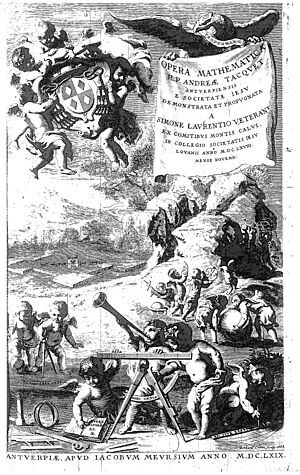André Tacquet facts for kids
André Tacquet (born June 23, 1612, in Antwerp; died December 22, 1660, in Antwerp) was a smart mathematician and a Catholic priest from a region called Brabant. This area is now part of modern-day Belgium.
Tacquet was a Jesuit, which is a religious order within the Catholic Church. He strongly believed in the geometry rules set by Euclid, a famous ancient Greek mathematician. He also followed the ideas of the philosopher Aristotle. Tacquet did not agree with a newer math idea called the "method of indivisibles."
Life of a Mathematician
André Tacquet was born in the city of Antwerp. He joined the Jesuit Order in 1629 when he was about 17 years old.
From 1631 to 1635, he studied important subjects like mathematics, physics, and logic at a university in Leuven. Two of his teachers were famous mathematicians themselves: Grégoire de Saint-Vincent and Francois d'Aguilon.
Tacquet became a very talented mathematician. People all over the world knew about his work. His books were often printed again and translated into other languages, like Italian and English.
His Most Famous Work
His most well-known book is Cylindricorum et annularium, published in 1651. This book was very important and influenced other great thinkers, like Blaise Pascal.
In this book, Tacquet explained how a moving point can create a curve. He also wrote about how to figure out the area of shapes and the volume of 3D objects.
André Tacquet passed away in his hometown of Antwerp.
To honor his contributions, a small crater on the Moon is named after him. It is located in the northeast part of the Moon, near the edge of a flat area called Mare Serenitatis.
Tacquet's Books
Here are some of the important books André Tacquet wrote:
- 1651: Cylindricorum et annularium libri IV (published in Antwerp) full text
- 1654: Elementa geometriae (published in Antwerp)
- 1656: Arithmeticae theoria et praxis (published in Louvain)
- 1659: Cylindricorum et annularium liber V (published in Antwerp) full text
- 1725: Elementa Euclideae, geometriae (published in Amsterdam) full text
See also
- List of Jesuit scientists
- List of Roman Catholic scientist-clerics




